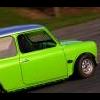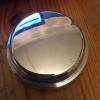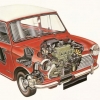Caliper Seal Question
#1

Posted 20 April 2010 - 10:16 AM
There are two recesses in the pistons "chamber" and the kit provides two seals per caliper plus a retaining ring...
Now when I fit the seals in both recesses (concave seal in top recess and square seal in bottom) I can't get the piston in. It gets stuck on the second (square) seal.
Is the bottom recess supposed to be unoccupied by a seal? Is the square seal the dust seal that sits outside the piston chamber?
Really confused as in my memory both seals were inside the piston chamber.
Please, any help will be greatly appreciated.
Cheers
#2

Posted 20 April 2010 - 10:25 AM
First of all you clean out all the DGS (dirt, grit and s***) from the caliper and wash it thoroughly with brake & clutch cleaner.
Then, using either brake fluid or brake seal grease as a lubricant, you fit the pressure seal and gently slide the new piston into the piston bore. Once the piston is fully installed, you lightly grease the machined register on the edge of the bore and push the dust seal in place. I use Aeroshell aircraft control system grease for this, but any light grease or even Vaseline is OK. In fact, fitting these dust seals is probably the most difficult thing on the whole job as if they kink at all then they become useless. You can run without them until you can buy more new ones., but it's not advised.
#3

Posted 20 April 2010 - 10:31 AM
I use brake fluid as lubricant,
So the concave rubber is the one that sits under the metal ring, then?
But what about the second recess? Is it empty?
Edited by Natcab, 20 April 2010 - 10:34 AM.
#4

Posted 20 April 2010 - 10:40 AM
Then there is an outer dust over seal which just stops the DGS getting in during use.
It's the inner square-section seal which is so vital. It must be fitted correctly, lubricated and have the piston slid in without it being damaged. If this does not happen you will risk total brake failure! I can't overstress this.
The outer seal is lightly pushed in after the piston is installed. It is not an easy operation, but it is not a safety-critical part in the short-term, although if not fitted and dirt gets in it could be a problem when the pads are changed later on.
There are no redundant grooves or machined slots. Remember, 2 seals per piston - inner one is square section, outer one is dust seal with metal surround.
If in doubt, come bak on here before fitting. Brakes are just a bit important!
#5

Posted 20 April 2010 - 12:09 PM
There IS more than one recess in the piston chamber so this made me confused.
I have rebuilt calipers before, big ones from my '68 vw camper so I'm not new to this but it's the first time I encounter this trouble.
I'll post pictures tonight.
#6

Posted 20 April 2010 - 12:46 PM
#7

Posted 20 April 2010 - 12:51 PM
I will post pictures tonite
#8

Posted 20 April 2010 - 08:29 PM
As most normal grease will kill rubber and synthetic rubbers very quickly
The main seal also does another job, it is the part that pulls your pads off the disc when you release the pedal pressure so that you get a very small clearance for your discs to spin freely
#9

Posted 21 April 2010 - 11:52 AM
It so happens I've been a donkey because I actually didn't remove the dust seal retaining ring
But even after removing it and cleaning everything to a high level I still only succeeded in fitting 1 piston correctly.
I know spent 2 seal kits and wrecked 2 stainless pistons on this stupid job.
The grease I use? Just brake fluid, I lube the piston chamber and the seal, then I position the piston, pour some more fluid in the recess so all is well lubed up, and then try
to push/drive/hit the piston home. Most of the time I just tear the seal and I have to try again.
I'm restoring on a budget so I don't want to splash out 200+ quid on a new/reconditioned pair. I just want safe brakes.
#10

Posted 21 April 2010 - 12:01 PM
So I promised pictures but got too frustrated again yesterday by wasting another 1,5 hours on this job.
It so happens I've been a donkey because I actually didn't remove the dust seal retaining ring
But even after removing it and cleaning everything to a high level I still only succeeded in fitting 1 piston correctly.
I know spent 2 seal kits and wrecked 2 stainless pistons on this stupid job.
The grease I use? Just brake fluid, I lube the piston chamber and the seal, then I position the piston, pour some more fluid in the recess so all is well lubed up, and then try
to push/drive/hit the piston home. Most of the time I just tear the seal and I have to try again.
I'm restoring on a budget so I don't want to splash out 200+ quid on a new/reconditioned pair. I just want safe brakes.
From my motorbiking caliper rebuilding days im pretty sure you are best off using proper for brake grease to push new pistons home in new seals as they will be
very tight. I found brake fluid is not acutally that oily/greasy it has a wierd texture.
Edited by bunch1980, 21 April 2010 - 12:02 PM.
#11

Posted 21 April 2010 - 12:22 PM
However as Bunch1980 says the correct grease is required, if you pinch a seal and don't know that you have done so.........
How did you wreck 2 pistons ?
Edited by mra-minis.co.uk, 21 April 2010 - 12:28 PM.
#12

Posted 27 April 2010 - 08:49 AM
The trick is to use the right grease. Ate caliper & brake cylinder grease is what you need.
All the time I was using brake fluid, and as suggested - it doesn't lubricate all that well.
I did ruin two pistons, because the poor lubricating capacities of the brake fluid caused the seal to rip as the piston was pushed down, so the piston was jammed inside so I had to clamp it in my vise and pry it out. So it has Vise-marks on it so not usable anymore.
I'm confident the seals didn't get ruptured this time because the piston is firm and moves slow but freely up and down with compressed air.
The dust seals and retaining ring went in fairly easy.
Thanks for all the advice, saved myself some money.
1 user(s) are reading this topic
0 members, 1 guests, 0 anonymous users

















